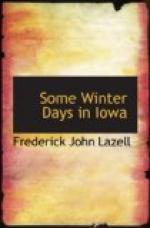These narrow tracks where dainty feet printed a double line of opposite dots across the snow were made by the whitefooted mouse, and the little continuous line between them was made by his dragging tail. The legend is like this, :-:-:-:-:-. Farther on are similar tracks, but alternate instead of opposite, like this,’,’,’,’. They were made by the short-tailed shrew. Still farther along a queer little ridge is seen in the snow across the wood road. It is the tunnel of the meadow mouse. Part of its fragile roof has fallen in and you may stoop and look into the little round tunnel which ran from the burrow to some granary under a log.
There goes a squirrel, angling away from you, his red bushy tail high in the air as he runs through the deep snow down the side of the ridge to a big, corky-barked oak, up which he goes to wait in his hollow up there until you have passed by. He did not seem to be going very fast but when you walk over to his tracks you find they are farther apart than you can step. The groups of four are about as broad as your hand, and they are deep where the snow lies thick. But on the firmer snow at the crest of the ridge, before the squirrel became alarmed, they did not break through the crust, and the marks of the dainty toes are plainly seen. There are also the remains of a sweet acorn which the squirrel dug out of the deep snow under a white oak. Back to the river where the stream from the spring makes open water you find some queer tracks on the fresh snow; there is a round spot as big as a quarter in each one, faint radiating lines in front ending with the marks of sharp toes; these were made by the soft-padded foot and webbed toes of the mink.
* * * * *
Most of the insect life is snugly hidden, but much is in plain sight. A clump of pussy willows bears many queer-shaped clusters which the entomologist calls pine cone galls; in the center of each one a larva dwells in his silken case. On the red oaks over head are other galls,—the oak apples. The buttonbush has the ash-colored cocoon of the giant silkworm, made out of a rolled leaf, the petiole of which is fastened to the branch with silk. Many others are to be found for the looking. All tell the story of Nature’s abundant life,—even the morning after a February snow storm. All speak
"Of one maternal spirit
bringing forth
And cherishing with ever constant
love,
That tires not, nor betrays."
But snowstorms will soon be over. The nature-lover’s spring begins near the end of the month, sometimes just before, sometimes just after. The snow and the ice will be honeycombed by the sun and we shall begin to look for the sap trickling from the maple, and to strain our ears for the first note of the wild goose and the blue-bird,
"While winter, slumbering
in the open air
Wears on his smiling face
a dream of spring."




